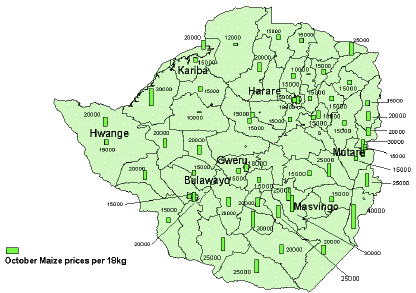|
Back to Index
Zimbabwe
Food Security Emergency 15 Nov 2004 - Extreme food insecurity
Famine Early
Warning System Network (FEWSNET)
November 15, 2004
http://www.reliefweb.int
Access to food
continues to be the biggest food security challenge in 2004/05.
In April 2004
the Zimbabwe Vulnerability Assessment Committee (ZimVAC) estimated
that about 2.2 million rural people would need food assistance between
August and November 2004 due to a combination of factors, including
inadequate household crop production, and shrinking income options.
This estimate was made on the assumption that grain would be available
from the Grain Marketing Board (GMB) at Z$471/kg. However, GMB maize
grain is now selling for at least Z$720/kg, and it is in short supply.
Where GMB maize is not available, many households are forced to
turn to the parallel markets to buy maize, where it sells for more
than Z$1,000. Given much higher maize prices and no evidence of
commensurate increases in rural incomes, the rural population in
need of food assistance must now be higher than that originally
estimated by the ZimVAC. In addition, significant general price
increases continue to limit the ability of poor urban households
to buy the food they need. These households make up close to 70
percent of Zimbabwe's urban population.
Maize price
increase threatens household food security in grain deficit areas
Maize grain
prices are normally expected to start increasing between December
and January, but they started going up soon after the harvest in
May/June 2004 in both the grain deficit and the grain surplus areas.
The grain surplus areas in the north central part of the country
saw maize prices rise from Z$8,000/bucket(18kg) in April and May
to between Z$10,000 and Z$15,000/bucket in October. Maize prices
in the grain deficit areas were around Z$15,000/bucket after the
harvest and had gone up to over Z$20,000/bucket by the end of October
2004.
Although cattle
and goat prices in the majority of the grain deficit rural areas
have risen by over 100 percent since April 2004, not more than 60
percent of households in these areas have sufficient animals to
enable them to take advantage of these higher prices.
Figure 1:
Parallel Market Maize Grain Prices (Z$/18kg) for Last Week of October
2004 in Selected Markets

Source: FEWS NET/USGS
The Consumer
Council of Zimbabwe (CCZ) estimates that in August 2004 a poor urban
family of six required about Z$1,400,078 to purchase basic commodities
and other essential services. The cost of the basket of basic goods
and services for the poor urban household went up by 6.6 percent
in September to Z$1,494,700. Minimum monthly wages for commercial
employees, pegged at Z$ 437,500 in September 2004, only cover about
29 percent of the CCZ total basket. Household income has been further
stretched by the demands of the agricultural season as most urban
households are procuring inputs for their urban plots or for sending
to relatives in rural areas.
Recommended
Actions
- The humanitarian
agencies with cereals left over when general feeding stopped soon
after the harvest in April should continue dialogue with the Government
to complement their food assistance program with general feeding
to populations identified by the ZimVAC to be in need of food
assistance.
- NGOs and
the government should embark on livelihoods recovery programs
better informed by livelihoods assessments such as the just released
Zimbabwe VAC assessments and the soon to be published Poverty
Assessment Study.
- Targeted
food aid should continue throughout the country for poor socio-economic
groups. Special attention is required for the most food insecure
districts of Manicaland and Matebeleland South Provinces.
- Rigorous
monitoring of the food security situation in highly food insecure
areas such as the districts of Masvingo, the Matebeleland, the
south of Manicaland and Zambezi Valley, should be stepped up given
the threat of famine in these areas.
Please credit www.kubatana.net if you make use of material from this website.
This work is licensed under a Creative Commons License unless stated otherwise.
TOP
|

